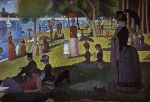IMPRESSIONISM
 The Impressionists, who got their name from one of
Monet's paintings, were interested in the effects of light. It was their
"attempt to accurately and objectively record visual reality in terms
of transient effects of light and colour" (2). Impressionis m was more
of a state of mind than an actual technique, for the artists did not depend
on the division of color. It is true that the brush strokes are separate,
but the artists focused on the method of observation, not theory. Impressionism
is based more on emotions and the passing moment than on science. For this
reason, Impressionist works are sketches. Artists like Monet
worked outside to capture the effects of the constantly changing
atmosphere. Lively colors and quick brushs strokes were used to capture
the texture of the subject and the impact of light on its surface rather
than individual details. Instead of mixing colors on a palette,
Impressionists placed the brush strokes on the canvas and let the
viewer's eye do the mixing of colors.
The Impressionists, who got their name from one of
Monet's paintings, were interested in the effects of light. It was their
"attempt to accurately and objectively record visual reality in terms
of transient effects of light and colour" (2). Impressionis m was more
of a state of mind than an actual technique, for the artists did not depend
on the division of color. It is true that the brush strokes are separate,
but the artists focused on the method of observation, not theory. Impressionism
is based more on emotions and the passing moment than on science. For this
reason, Impressionist works are sketches. Artists like Monet
worked outside to capture the effects of the constantly changing
atmosphere. Lively colors and quick brushs strokes were used to capture
the texture of the subject and the impact of light on its surface rather
than individual details. Instead of mixing colors on a palette,
Impressionists placed the brush strokes on the canvas and let the
viewer's eye do the mixing of colors.
NEO-IMPRESSIONISM
 The Neo-Impressionist movement took the colors
and themes of Impressionism, but rejected the Impressionists' ephemeral
treatment of their subjects. Lead by Seurat,
the Neo-Impressionists to ok a more systematic approach to art. They focused
on the theory and division of color and vision, breaking things down to
a more fundamental and basic level (see Reductionism).
For example , through pointilism, Seurat broke the image on his canvas down
into tiny dots of color.
The Neo-Impressionist movement took the colors
and themes of Impressionism, but rejected the Impressionists' ephemeral
treatment of their subjects. Lead by Seurat,
the Neo-Impressionists to ok a more systematic approach to art. They focused
on the theory and division of color and vision, breaking things down to
a more fundamental and basic level (see Reductionism).
For example , through pointilism, Seurat broke the image on his canvas down
into tiny dots of color.
Return to the Architectonic
Article: Jennifer King
May 25, 1996.
 The Impressionists, who got their name from one of
Monet's paintings, were interested in the effects of light. It was their
"attempt to accurately and objectively record visual reality in terms
of transient effects of light and colour" (2). Impressionis m was more
of a state of mind than an actual technique, for the artists did not depend
on the division of color. It is true that the brush strokes are separate,
but the artists focused on the method of observation, not theory. Impressionism
is based more on emotions and the passing moment than on science. For this
reason, Impressionist works are sketches. Artists like Monet
worked outside to capture the effects of the constantly changing
atmosphere. Lively colors and quick brushs strokes were used to capture
the texture of the subject and the impact of light on its surface rather
than individual details. Instead of mixing colors on a palette,
Impressionists placed the brush strokes on the canvas and let the
viewer's eye do the mixing of colors.
The Impressionists, who got their name from one of
Monet's paintings, were interested in the effects of light. It was their
"attempt to accurately and objectively record visual reality in terms
of transient effects of light and colour" (2). Impressionis m was more
of a state of mind than an actual technique, for the artists did not depend
on the division of color. It is true that the brush strokes are separate,
but the artists focused on the method of observation, not theory. Impressionism
is based more on emotions and the passing moment than on science. For this
reason, Impressionist works are sketches. Artists like Monet
worked outside to capture the effects of the constantly changing
atmosphere. Lively colors and quick brushs strokes were used to capture
the texture of the subject and the impact of light on its surface rather
than individual details. Instead of mixing colors on a palette,
Impressionists placed the brush strokes on the canvas and let the
viewer's eye do the mixing of colors. The Neo-Impressionist movement took the colors
and themes of Impressionism, but rejected the Impressionists' ephemeral
treatment of their subjects. Lead by
The Neo-Impressionist movement took the colors
and themes of Impressionism, but rejected the Impressionists' ephemeral
treatment of their subjects. Lead by